Abstract
Legionella jordanis sp. nov., as found in two cultures, is described. One isolate was from river water in Indiana and the other isolate was from sewage in DeKalb County, Ga. The former is the type strain of the species, and is designated BL-540 (ATCC 33623). L. jordanis had a partial relationship to L. bozemanii by direct fluorescent-antibody tests but was unrelated to L. pneumophila, L. dumoffii, L. micdadei, L. gormanii, or L. longbeachae. Legionella phenotypic characteristics, including large amounts of branched-chain cellular fatty acids, were shown by the isolates. Studies of DNA relatedness showed that the two cultures of L. jordanis were only slightly related to the six previously described species of Legionella but were more than 90% related to each other. Indirect fluorescent-antibody tests with human sera suggested that unrecognized human infections with L. jordanis may be occurring.
Full text
PDF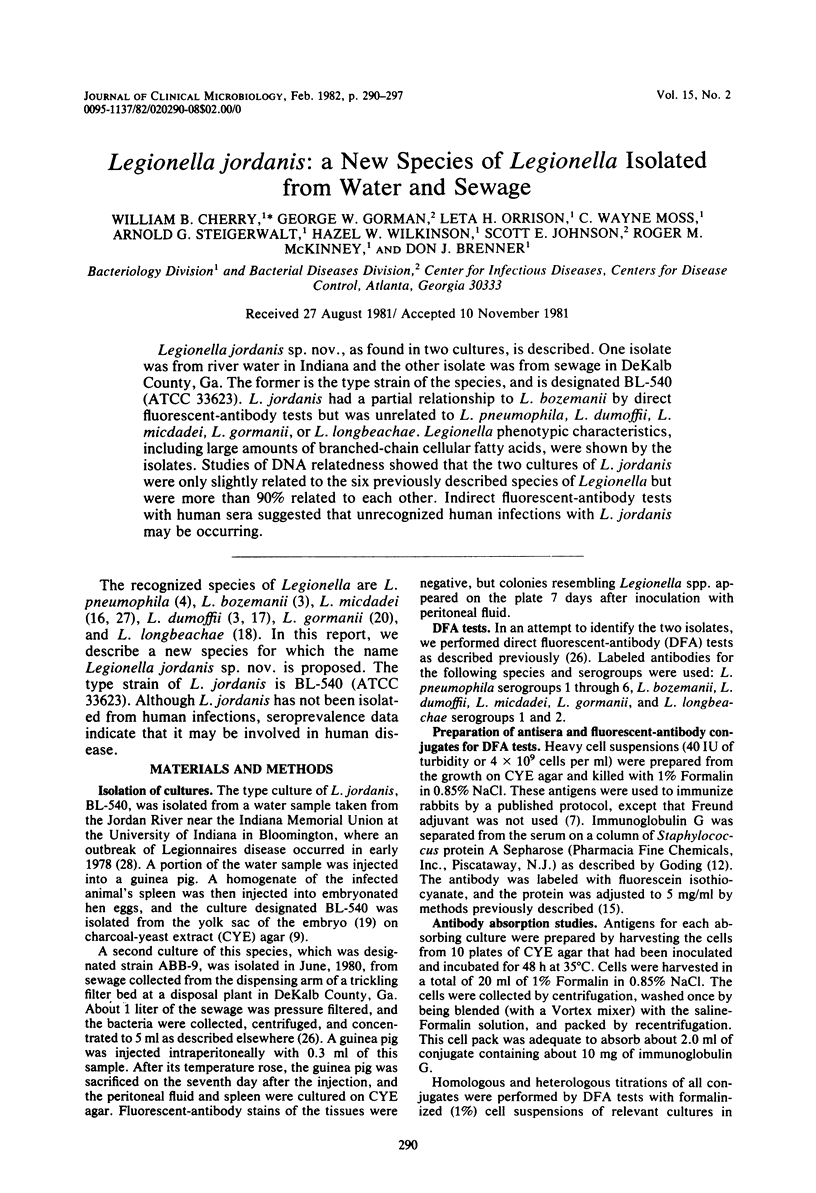
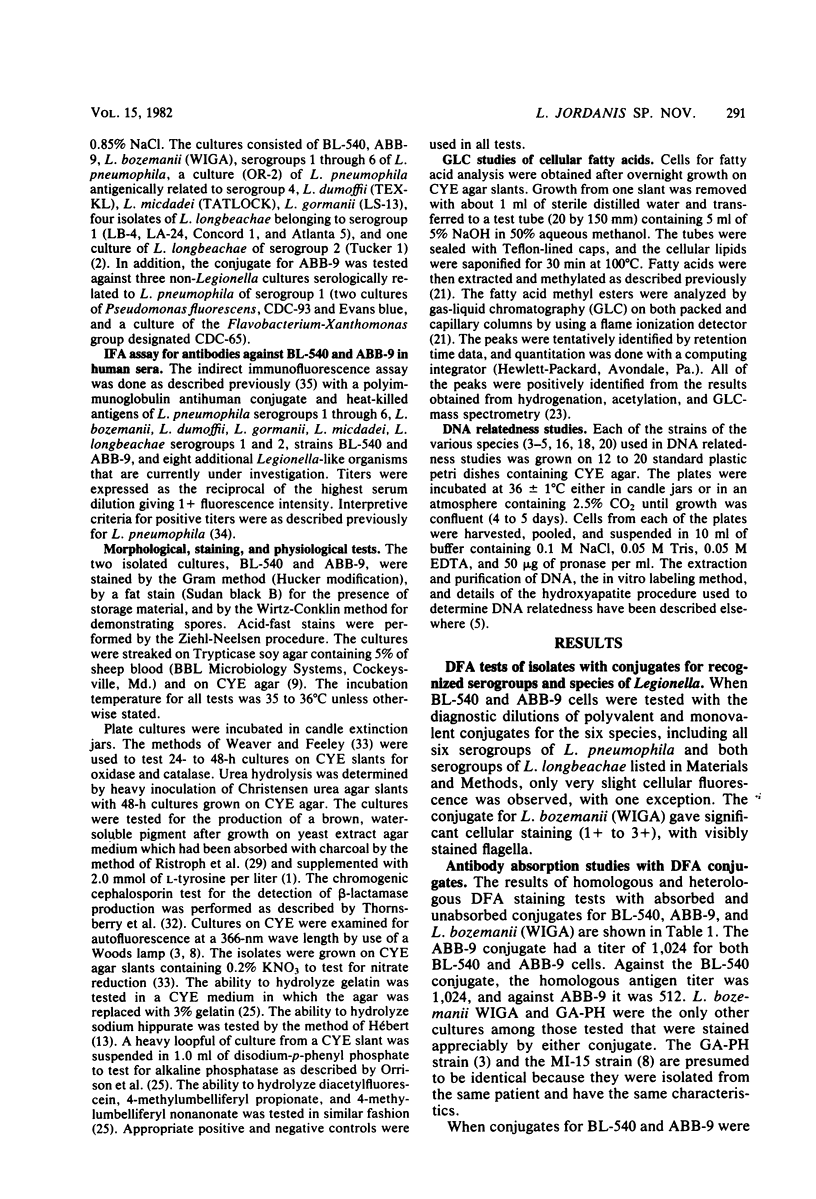
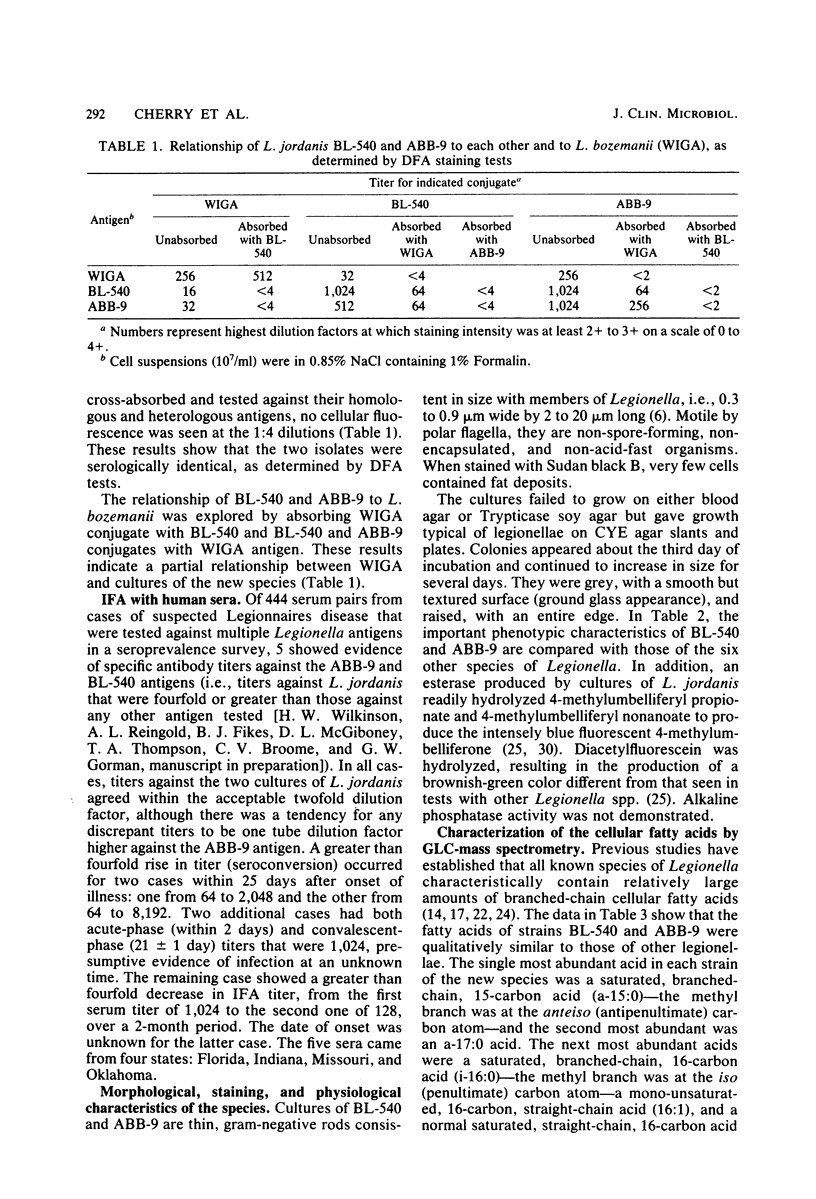
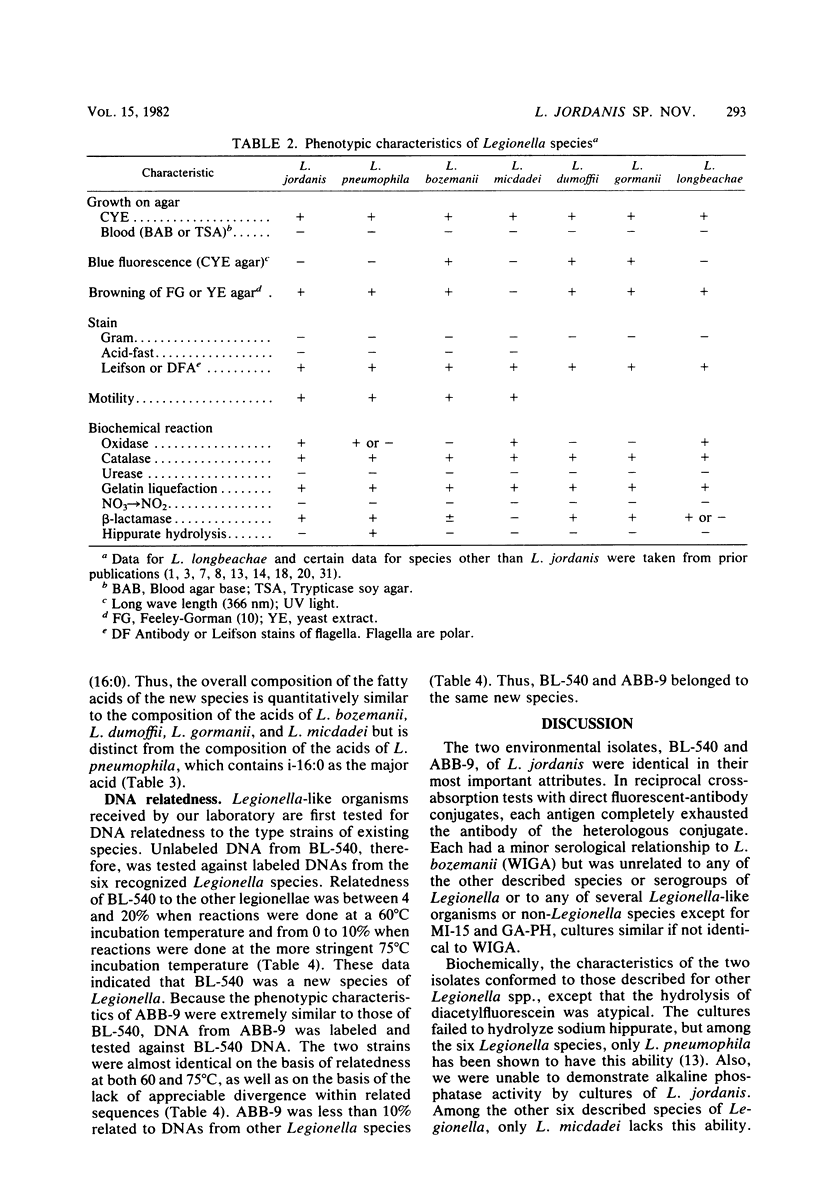
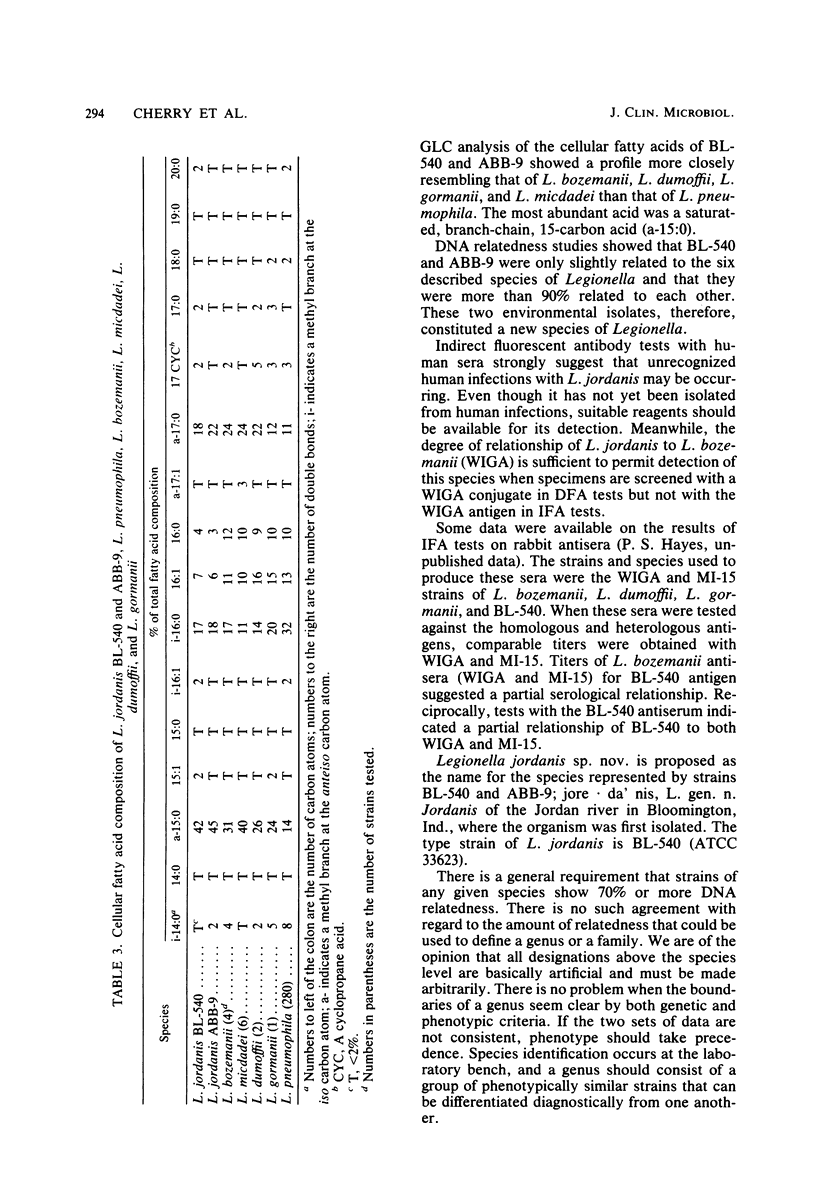
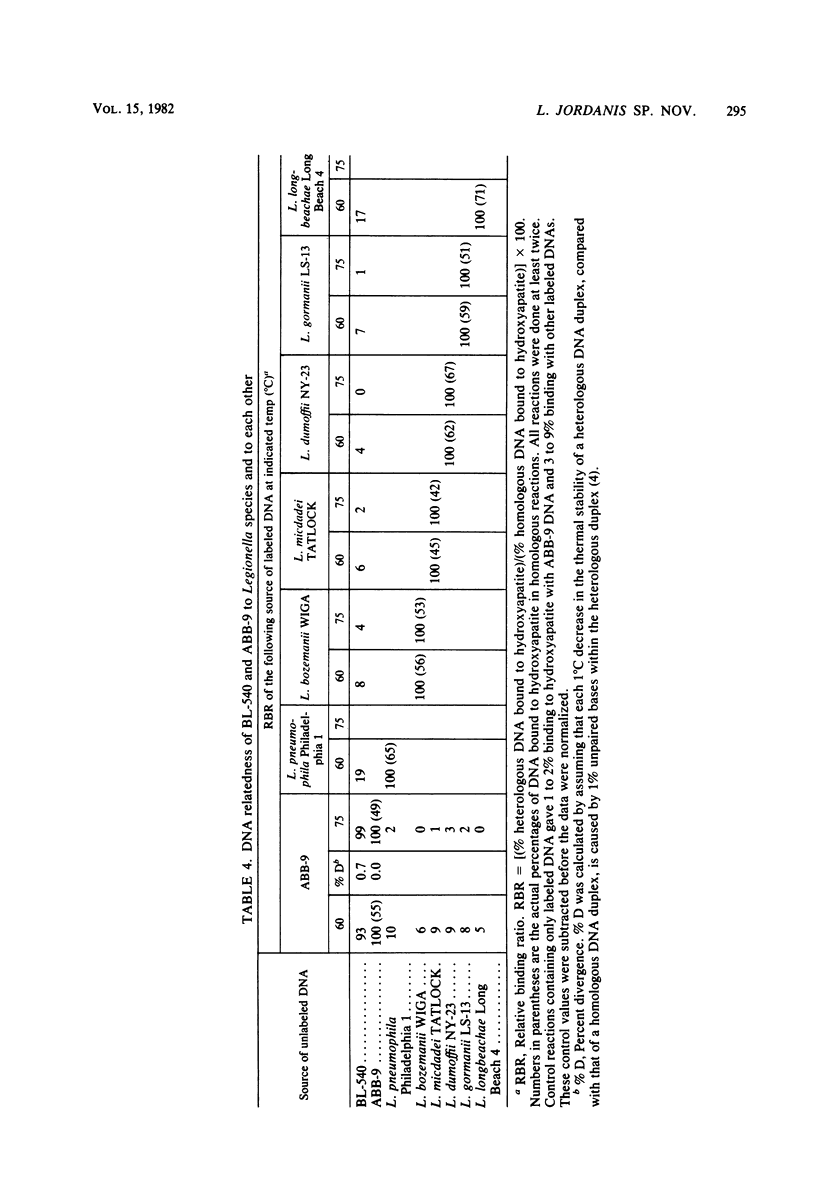
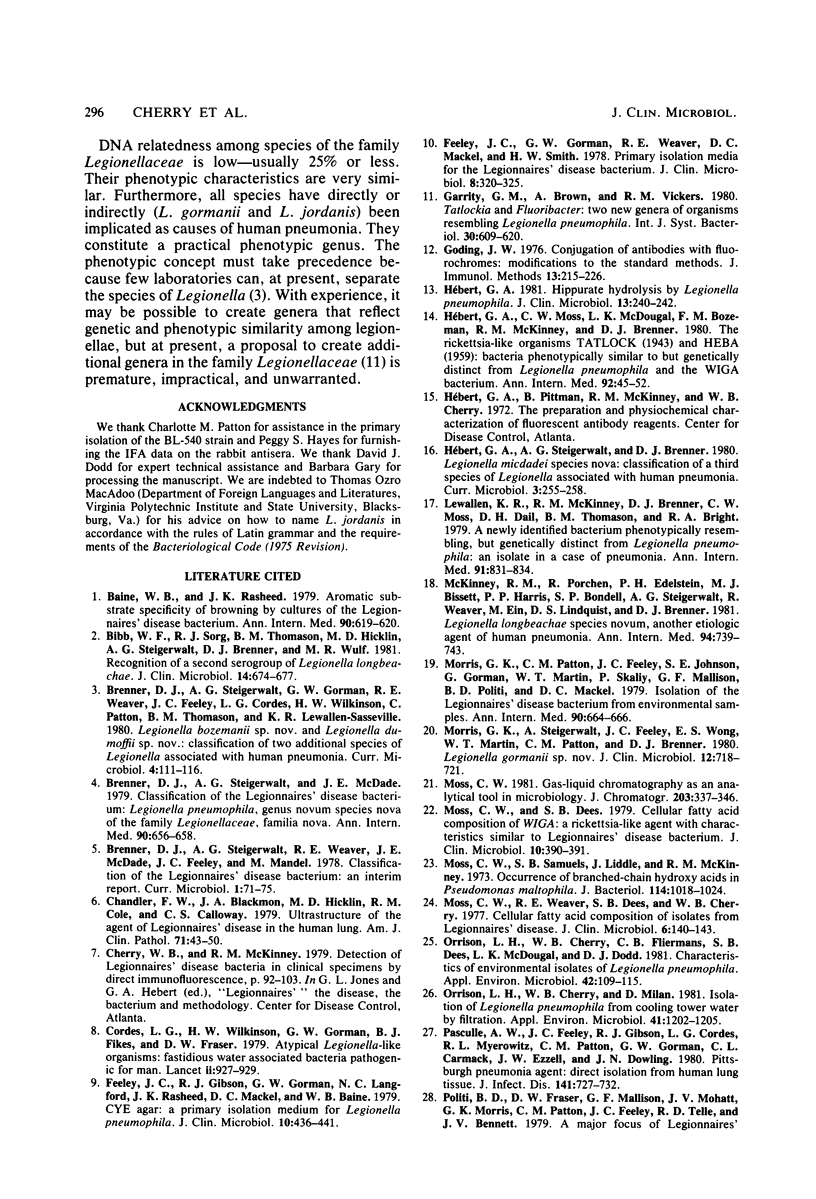
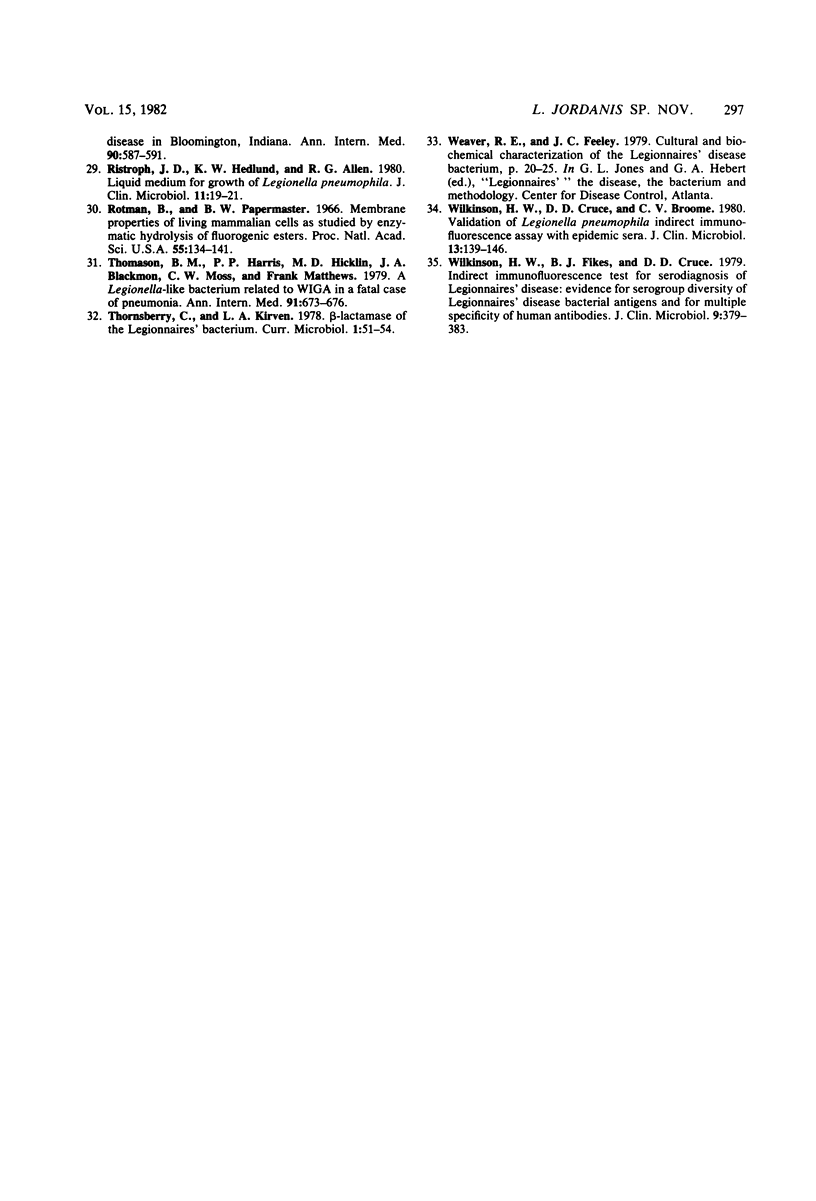
Selected References
These references are in PubMed. This may not be the complete list of references from this article.
- Baine W. B., Rasheed J. K. Aromatic substrate specificity of browning by cultures of the Legionnaires' disease bacterium. Ann Intern Med. 1979 Apr;90(4):619–620. doi: 10.7326/0003-4819-90-4-619. [DOI] [PubMed] [Google Scholar]
- Bibb W. F., Sorg R. J., Thomason B. M., Hicklin M. D., Steigerwalt A. G., Brenner D. J., Wulf M. R. Recognition of a second serogroup of Legionella longbeachae. J Clin Microbiol. 1981 Dec;14(6):674–677. doi: 10.1128/jcm.14.6.674-677.1981. [DOI] [PMC free article] [PubMed] [Google Scholar]
- Brenner D. J., Steigerwalt A. G., McDade J. E. Classification of the Legionnaires' disease bacterium: Legionella pneumophila, genus novum, species nova, of the family Legionellaceae, familia nova. Ann Intern Med. 1979 Apr;90(4):656–658. doi: 10.7326/0003-4819-90-4-656. [DOI] [PubMed] [Google Scholar]
- Chandler F. W., Blackmon J. A., Hicklin M. D., Cole R. M., Callaway C. S. Ultrastructure of the agent of Legionnaires' disease in the human lung. Am J Clin Pathol. 1979 Jan;71(1):43–50. doi: 10.1093/ajcp/71.1.43. [DOI] [PubMed] [Google Scholar]
- Cordes L. G., Wilkinson H. W., Gorman G. W., Fikes B. J., Fraser D. W. Atypical Legionella-like organisms: fastidious water-associated bacteria pathogenic for man. Lancet. 1979 Nov 3;2(8149):927–930. doi: 10.1016/s0140-6736(79)92623-0. [DOI] [PubMed] [Google Scholar]
- Feeley J. C., Gibson R. J., Gorman G. W., Langford N. C., Rasheed J. K., Mackel D. C., Baine W. B. Charcoal-yeast extract agar: primary isolation medium for Legionella pneumophila. J Clin Microbiol. 1979 Oct;10(4):437–441. doi: 10.1128/jcm.10.4.437-441.1979. [DOI] [PMC free article] [PubMed] [Google Scholar]
- Feeley J. C., Gorman G. W., Weaver R. E., Mackel D. C., Smith H. W. Primary isolation media for Legionnaires disease bacterium. J Clin Microbiol. 1978 Sep;8(3):320–325. doi: 10.1128/jcm.8.3.320-325.1978. [DOI] [PMC free article] [PubMed] [Google Scholar]
- Goding J. W. Conjugation of antibodies with fluorochromes: modifications to the standard methods. J Immunol Methods. 1976;13(3-4):215–226. doi: 10.1016/0022-1759(76)90068-5. [DOI] [PubMed] [Google Scholar]
- Hébert G. A. Hippurate hydrolysis by Legionella pneumophila. J Clin Microbiol. 1981 Jan;13(1):240–242. doi: 10.1128/jcm.13.1.240-242.1981. [DOI] [PMC free article] [PubMed] [Google Scholar]
- Hébert G. A., Moss C. W., McDougal L. K., Bozeman F. M., McKinney R. M., Brenner D. J. The rickettsia-like organisms TATLOCK (1943) and HEBA (1959): bacteria phenotypically similar to but genetically distinct from Legionella pneumophila and the WIGA bacterium. Ann Intern Med. 1980 Jan;92(1):45–52. doi: 10.7326/0003-4819-92-1-45. [DOI] [PubMed] [Google Scholar]
- Lewallen K. R., McKinney R. M., Brenner D. J., Moss C. W., Dail D. H., Thomason B. M., Bright R. A. A newly identified bacterium phenotypically resembling, but genetically distinct from, Legionella pneumophila: an isolate in a case of pneumonia. Ann Intern Med. 1979 Dec;91(6):831–834. doi: 10.7326/0003-4819-91-6-831. [DOI] [PubMed] [Google Scholar]
- McKinney R. M., Porschen R. K., Edelstein P. H., Bissett M. L., Harris P. P., Bondell S. P., Steigerwalt A. G., Weaver R. E., Ein M. E., Lindquist D. S. Legionella longbeachae species nova, another etiologic agent of human pneumonia. Ann Intern Med. 1981 Jun;94(6):739–743. doi: 10.7326/0003-4819-94-6-739. [DOI] [PubMed] [Google Scholar]
- Morris G. K., Patton C. M., Feeley J. C., Johnson S. E., Gorman G., Martin W. T., Skaliy P., Mallison G. F., Politi B. D., Mackel D. C. Isolation of the Legionnaires' disease bacterium from environmental samples. Ann Intern Med. 1979 Apr;90(4):664–666. doi: 10.7326/0003-4819-90-4-664. [DOI] [PubMed] [Google Scholar]
- Morris G. K., Steigerwalt A., Feeley J. C., Wong E. S., Martin W. T., Patton C. M., Brenner D. J. Legionella gormanii sp. nov. J Clin Microbiol. 1980 Nov;12(5):718–721. doi: 10.1128/jcm.12.5.718-721.1980. [DOI] [PMC free article] [PubMed] [Google Scholar]
- Moss C. W., Dees S. B. Cellular fatty acid composition of WIGA, a rickettsia-like agent similar to the Legionnaires disease bacterium. J Clin Microbiol. 1979 Sep;10(3):390–391. doi: 10.1128/jcm.10.3.390-391.1979. [DOI] [PMC free article] [PubMed] [Google Scholar]
- Moss C. W. Gas-liquid chromatography as an analytical tool in microbiology. J Chromatogr. 1981 Jan 9;203:337–347. doi: 10.1016/s0021-9673(00)80305-2. [DOI] [PubMed] [Google Scholar]
- Moss C. W., Samuels S. B., Liddle J., McKinney R. M. Occurrence of branched-cahin hydroxy fatty acids in Pseudomonas maltophilia. J Bacteriol. 1973 Jun;114(3):1018–1024. doi: 10.1128/jb.114.3.1018-1024.1973. [DOI] [PMC free article] [PubMed] [Google Scholar]
- Moss C. W., Weaver R. E., Dees S. B., Cherry W. B. Cellular fatty acid composition of isolates from Legionnaires disease. J Clin Microbiol. 1977 Aug;6(2):140–143. doi: 10.1128/jcm.6.2.140-143.1977. [DOI] [PMC free article] [PubMed] [Google Scholar]
- Orrison L. H., Cherry W. B., Fliermans C. B., Dees S. B., McDougal L. K., Dodd D. J. Characteristics of environmental isolates of Legionella pneumophila. Appl Environ Microbiol. 1981 Jul;42(1):109–115. doi: 10.1128/aem.42.1.109-115.1981. [DOI] [PMC free article] [PubMed] [Google Scholar]
- Orrison L. H., Cherry W. B., Milan D. Isolation of Legionella pneumophilia from cooling tower water by filtration. Appl Environ Microbiol. 1981 May;41(5):1202–1205. doi: 10.1128/aem.41.5.1202-1205.1981. [DOI] [PMC free article] [PubMed] [Google Scholar]
- Pasculle A. W., Feeley J. C., Gibson R. J., Cordes L. G., Myerowitz R. L., Patton C. M., Gorman G. W., Carmack C. L., Ezzell J. W., Dowling J. N. Pittsburgh pneumonia agent: direct isolation from human lung tissue. J Infect Dis. 1980 Jun;141(6):727–732. doi: 10.1093/infdis/141.6.727. [DOI] [PubMed] [Google Scholar]
- Politi B. D., Fraser D. W., Mallison G. F., Mohatt J. V., Morris G. K., Patton C. M., Feeley J. C., Telle R. D., Bennett J. V. A major focus of Legionnaires' disease in Bloomington, Indiana. Ann Intern Med. 1979 Apr;90(4):587–591. doi: 10.7326/0003-4819-90-4-587. [DOI] [PubMed] [Google Scholar]
- Ristroph J. D., Hedlund K. W., Allen R. G. Liquid medium for growth of Legionella pneumophila. J Clin Microbiol. 1980 Jan;11(1):19–21. doi: 10.1128/jcm.11.1.19-21.1980. [DOI] [PMC free article] [PubMed] [Google Scholar]
- Rotman B., Papermaster B. W. Membrane properties of living mammalian cells as studied by enzymatic hydrolysis of fluorogenic esters. Proc Natl Acad Sci U S A. 1966 Jan;55(1):134–141. doi: 10.1073/pnas.55.1.134. [DOI] [PMC free article] [PubMed] [Google Scholar]
- Thomason B. M., Harris P. P., Hicklin M. D., Blackmon J. A., Moss W., Matthews F. A Legionella-like bacterium related to WIGA in a fatal case of pneumonia. Ann Intern Med. 1979 Nov;91(5):673–676. doi: 10.7326/0003-4819-91-5-673. [DOI] [PubMed] [Google Scholar]
- Wilkinson H. W., Cruce D. D., Broome C. V. Validation of Legionella pneumophila indirect immunofluorescence assay with epidemic sera. J Clin Microbiol. 1981 Jan;13(1):139–146. doi: 10.1128/jcm.13.1.139-146.1981. [DOI] [PMC free article] [PubMed] [Google Scholar]
- Wilkinson H. W., Fikes B. J., Cruce D. D. Indirect immunofluorescence test for serodiagnosis of Legionnaires disease: evidence for serogroup diversity of Legionnaires disease bacterial antigens and for multiple specificity of human antibodies. J Clin Microbiol. 1979 Mar;9(3):379–383. doi: 10.1128/jcm.9.3.379-383.1979. [DOI] [PMC free article] [PubMed] [Google Scholar]


